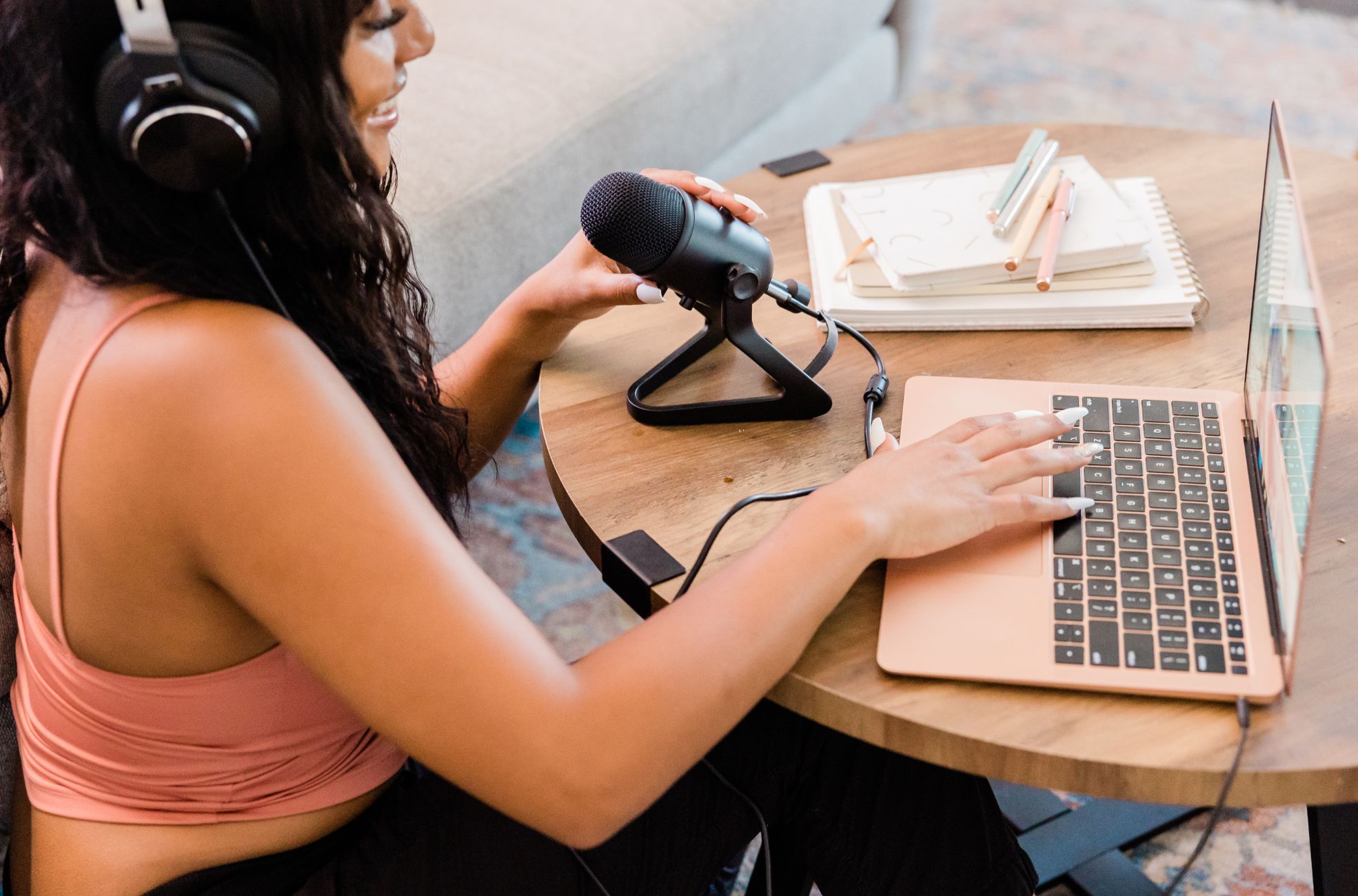Starting a podcast business can be exciting for those looking to share their voices and stories with a global audience. As a blend of creativity and strategy, it requires careful planning and a passion for the subject matter. Whether you’re aiming to entertain, educate, or inspire, establishing a podcast can open doors to a community of listeners and opportunities for monetisation.
We’ll walk you through the essentials, from conceptualising your unique podcast idea to technical setup, production, and marketing. We’ll also explore ways to monetise your podcast to turn your passion into profit. With the right approach, your podcast business can flourish, creating a lasting impact on your audience while generating income.
Conceptualising Your Podcast
Defining Your Niche and Audience
When you’re starting a podcast, pinpointing a specific niche is a critical first step. A niche is a focused topic that appeals to a particular segment of listeners. The more defined your niche; the easier it is for potential listeners to understand what your podcast offers and why they should tune in.
In a sea of podcasts, having a unique angle on a subject can make your show stand out, especially if it’s underserved by existing content. Selecting a niche is a deeply personal choice, but it should also consider what others are interested in. To identify a suitable niche, think about what advice people often seek from you, topics you’re knowledgeable about, and your hobbies.
Your enthusiasm for the subject will be a driving force in maintaining your podcast, so choosing something you’re passionate about is crucial. At the same time, you need to make sure there’s an audience who will find value in your content. As your podcast evolves, you might adjust your niche to better align with your growing understanding of your audience and your own interests.
Crafting Your Podcast Value Proposition
Your podcast’s value proposition is the promise of the benefit that listeners will receive from tuning in. It’s the reason why someone should choose your podcast over another. A compelling value proposition is tailored to your unique strengths and the specific needs of your ideal listener.
It should articulate how your podcast addresses a problem or enriches the listener’s life in a way that no other show does. This could be through providing expert insights, offering entertainment, or creating a community around a shared interest.
Establishing Your Brand Identity
Your podcast’s brand identity is the combination of visual elements, tone, and messaging that collectively convey the essence of your show to your audience. It’s how listeners perceive your podcast and what sets it apart from others. A strong brand strategy integrates the visual design, content, and structure to communicate your brand’s personality.
For example, TED Talks expanded into the podcast realm with TED Talks Daily, leveraging their established brand to reach listeners interested in absorbing diverse stories on the move. The brand voice, which is reflected in the language and style of communication with your audience, is a key component of your brand identity and influences how your podcast is perceived.
Determining the Format and Structure
The format and structure of your podcast are foundational elements that contribute to its overall flow and listener experience. A well-structured podcast will have a clear beginning, middle, and end, allowing for creative expression within the chosen format. Essential components include an engaging introduction, compelling main content, and a satisfying conclusion.
The structure helps captivate listeners, simplifies the editing process, and ensures interviews run smoothly. Considering the significant time investment required to produce each episode—often six to eight times the episode’s length—it’s wise to keep episodes concise and focused on delivering the intended message. Using a script or outline can guide the segmentation of content, placement of transitions, and integration of sponsor messages.
To foster growth and attract new listeners, including a call-to-action at the end of each episode is a strategic move, prompting engagement and furthering the reach of your podcast.

Technical Setup for Your Podcast
Choosing Your Recording Equipment
Your initial setup can be modest, utilising devices at hand for your first recordings. However, investing in higher-quality audio equipment becomes beneficial as your podcast gains traction. Understanding the basics of audio specifications will assist you in selecting appropriate gear that meets your podcast’s requirements without exceeding your financial limits.
For those just starting out, the essentials may already be within reach. When it comes to editing, headphones are indispensable for detecting subtle audio nuances. While basic earbuds will suffice initially, headphones with an integrated microphone offer a practical and economical solution for both recording and editing tasks. The microphones in most smartphones and laptops are adequate for beginners, but they often capture ambient noise and reverberations. A USB microphone is a simple and cost-effective improvement, providing clearer sound with minimal setup.
USB microphones are user-friendly, requiring only a connection to your device, and are reasonably priced. When selecting a USB microphone, consider the pickup pattern that suits your recording environment. Cardioid patterns, which capture sound in a heart-shaped area, are ideal for confined spaces and are prevalent in budget-friendly USB microphones.
An omnidirectional pattern may be more suitable for larger recording environments, as it captures sound from all directions.
Selecting the Right Audio Editing Software
Post-recording and editing are crucial steps, and a digital audio workstation (DAW) is essential. There is a variety of DAWs available that are either complimentary or inexpensive.
These platforms allow you to visualise your audio, facilitating the identification and correction of volume discrepancies or extraneous noises. You can efficiently refine your recordings and distribute your podcast with the appropriate software.
Investing in Quality Microphones
For a significant enhancement in audio fidelity, professional XLR microphones are a sound investment. These microphones often come equipped with features such as pop filters and noise-cancellation capabilities, streamlining the editing process. Despite their professional grade, there are XLR microphones on the market that are reasonably priced, making them accessible for home studio setups.
Essential Accessories for Recording
A pop filter is a vital accessory to ensure pristine recordings, mitigating the impact of plosive consonants. This device can be conveniently affixed to your microphone stand.
The quality of cables linking your equipment is also pivotal to audio quality. Shorter cables are preferable for maintaining signal integrity, and those with premium connectors, such as gold or silver, ensure optimal sound transmission.
Moreover, cables should be encased in a durable rubber jacket to prolong their lifespan. The specific types of cables required will vary based on your setup, but prioritising high-quality cables is essential for maintaining excellent audio quality in your recordings.

Creating Your Recording Space
Finding the Ideal Location
Establishing a dedicated recording space is crucial to embarking on a successful podcasting journey. Opt for a smaller room to minimise echo and enhance the clarity of your recordings. A walk-in closet can serve as an effective makeshift studio, with clothing providing natural sound absorption.
Consider using room dividers for larger areas to create a more intimate acoustic environment.
DIY Soundproofing Techniques
After selecting the right location, improve the sound quality with DIY soundproofing. Soft furnishings can be strategically placed to absorb sound. Inexpensive moving blankets are effective for draping over hard surfaces to reduce reverberation.
Covering windows and doors with these blankets can also minimise external noise intrusion. Additionally, acoustic panels can be installed to dampen unwanted sounds further.
Optimising the Acoustics
Enhancing the acoustics involves sound diffusion as well as soundproofing. Arrange furniture and plants to disrupt sound wave patterns, preventing them from reflecting directly back to your microphone. Avoid rooms with inherently poor acoustics, such as those with excessive noise from the surroundings.
Ensure that appliances that could cause interference, such as air conditioners and fans, are either turned off or removed from the recording area.
Room Setup and Ergonomics
The arrangement of your recording space is important for both sound quality and personal comfort. Positioning yourself in the centre of the room can help maintain even reverb. It’s important to manage lighting for video podcasts to prevent harsh shadows.
Consider using video conferencing software paired with high-quality audio when conducting remote interviews. Record during quieter times to minimise disruptions display a “do not disturb” sign and consider a vocal booth box for your microphone. Utilise audio enhancement tools from platforms like Spotify for Podcasters to refine their sound by balancing voices and reducing background noise, particularly when recording in challenging conditions or while mobile.

Production and Post-Production
Planning Your Episodes
A structured approach to episode planning is essential for maintaining listener engagement and encouraging subscriptions. Consistency in episode length can also be beneficial. Each episode should be centred around a specific message or insight you wish to convey. Implementing a three-act structure can enhance your storytelling and keep your narrative captivating. The pacing of your episode is crucial; it should maintain a balance to keep the audience’s attention.
The opening of your episode should set the stage for what’s to come, including a warm greeting. Engaging the audience with questions early on can emphasise the episode’s relevance. Opportunities to cross-promote your content should be taken, guiding listeners to other resources you offer.
Concluding an episode effectively is important for leaving your audience with a sense of fulfilment. Expressing gratitude and reiterating key takeaways should be included in your closing remarks. Employing templates can aid in sustaining a consistent and compelling narrative structure.
Effective Interviewing and Hosting Skills
Preparation is key to keeping podcast conversations engaging. Providing guests with a list of topics can result in more natural dialogue. Ensuring your recording setup is optimal before starting the interview is crucial. Recording pre-interview conversations can help relax your guests.
Active listening during the interview is essential, as it can lead to a richer dialogue. Interruptions may be necessary to delve deeper into topics or keep the conversation on track. A light-hearted approach can make the interview more enjoyable for both listeners and guests.
Post-interview, inform your guest about the next steps and express your appreciation for their participation.
Editing for Clarity and Engagement
In the editing phase, you refine your content, excising mistakes and enhancing sound quality. Incorporating sound design elements can add emotional layers to your podcast. Mixing and mastering are vital for achieving uniform audio levels.
Eliminating extraneous sounds and hesitations can significantly enhance the speaker’s perceived confidence. Trimming content that doesn’t contribute to the narrative is also essential. Levelling audio ensures a consistent listening experience.
Intros and outros establish a recognisable beginning and end to your podcast. Repeatedly reviewing your material is necessary to guarantee quality and identify any overlooked errors.
Adding Music and Sound Effects
Incorporating music and sound effects can enrich the podcast’s atmosphere and maintain audience interest. Promoting additional content during the episode can expand your listener base and increase platform traffic. Ensuring the episode concludes with a sense of completion is crucial.
Adding credits or a musical fade-out can provide a professional touch to the end of your podcast. Utilising robust templates can assist in maintaining a consistent and engaging narrative.

Launching and Marketing Your Podcast
Distributing Your Podcast Across Platforms
Selecting a podcast hosting service is a pivotal step in sharing your show. This platform will store your episodes and distribute them to popular listening platforms such as Spotify, Apple Podcasts, and Google Podcasts. With a multitude of hosting services available, it’s crucial to choose one that simplifies the process for you, as recommended by marketing professionals.
While hosting services typically provide RSS feeds, they may not all automatically distribute your podcast to listening platforms. If your chosen service doesn’t handle distribution, you must submit your podcast to these platforms yourself. Some services offer comprehensive packages that include distribution, audience analytics, and monetisation opportunities, often for a fee. Free hosting options are available, but they may limit certain features like storage space and monetisation potential.
Building an Online Presence
Creating a strong online presence is essential for your podcast’s discoverability. Many hosting sites offer the convenience of archiving your episodes on customisable pages, which can serve as your podcast’s primary online hub if you opt out of a separate website. This presence is not only for hosting content but also for providing sharing capabilities that aid in marketing your podcast. Linking your podcast with a WordPress site or blog, your TikTok account, Facebook or Instagram can further extend your reach and facilitate audience engagement.
Strategic Marketing and Promotion
Employing a variety of promotional tools and tactics is critical to effective marketing. Platforms such as Acast and Buzzsprout offer features allowing you to promote your podcast directly from your browser or social media by converting audio into shareable video clips. Interacting with your audience through live streams, Q&As, and polls can enhance engagement and foster loyalty. Additionally, some platforms feature marketing suites or community forums where podcasters can share promotional advice.
Monetisation Strategies for Your Podcast
Podcasters have multiple avenues for generating revenue from their content. Platforms like Podbean and Anchor provide monetisation tools that enable creators to profit through advertisements, listener subscriptions, and donations. Services such as Megaphone and Transistor offer dynamic ad insertion, streamlining the management of sponsorships. For those interested in offering exclusive content, platforms like Hello Audio and Castos present options for private podcasts and listener contributions. It’s important to consider the monetisation capabilities of a hosting service, as they can significantly influence your show’s revenue potential.
Consider the trade-off between desired features and cost when choosing a hosting service. Many services offer scalable plans, allowing you to expand your capabilities as your podcast audience grows. The cost of hosting typically correlates with your audience size and the length of your episodes. While free platforms like Spotify are suitable for novices, access to advanced features may incur additional costs. Selecting the most appropriate platform for your podcast involves balancing the necessary features with an acceptable price point.
Your Podcasting Journey Awaits
Embracing the podcasting path opens up a world of opportunity, letting you connect with audiences, share your unique insights, and even turn a passion into a profitable venture. While the upfront effort may seem formidable, your perseverance will be rewarded with every download, every engaged listener, and each successful episode that bears your signature style.
Remember, the key to a flourishing podcast lies in the value you bring to your listeners. Stay genuine, be consistent, and consistently seek to refine your content—these principles are your guiding stars. As you embark on this exciting journey, know that your voice has the power to resonate, inspire, and entertain a global community eager for your next instalment. Now, go forth and let the airwaves carry your story to the waiting ears of the world.









